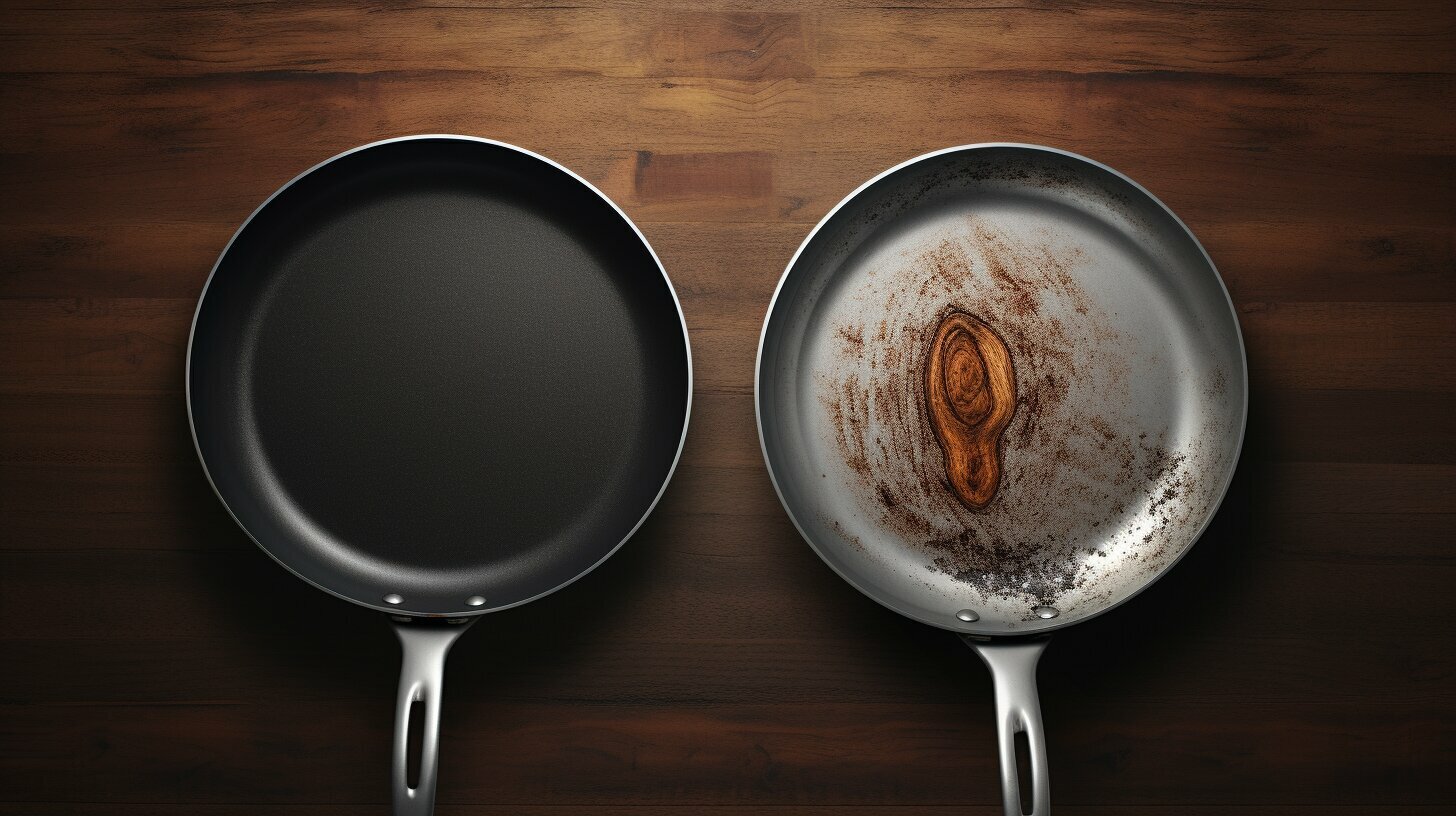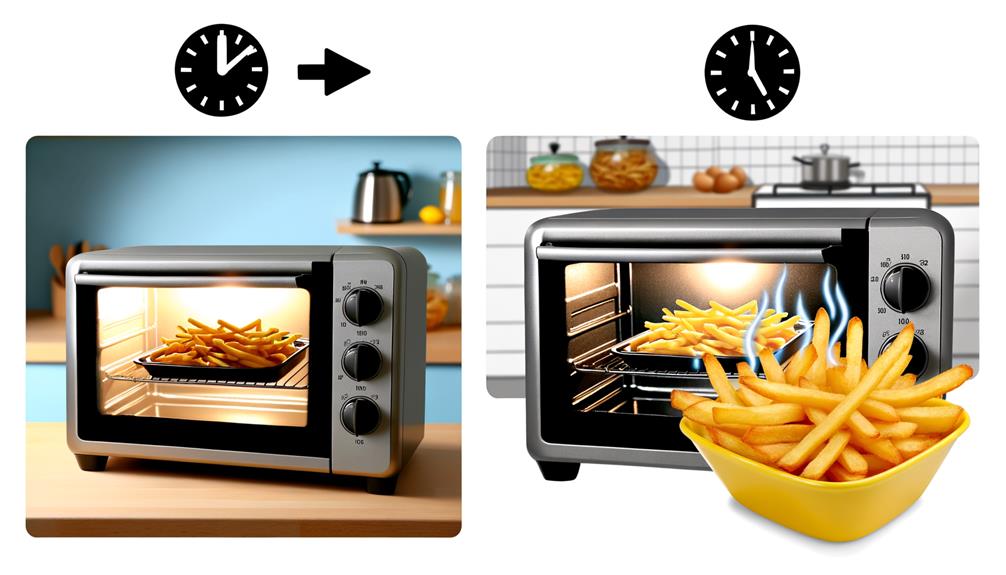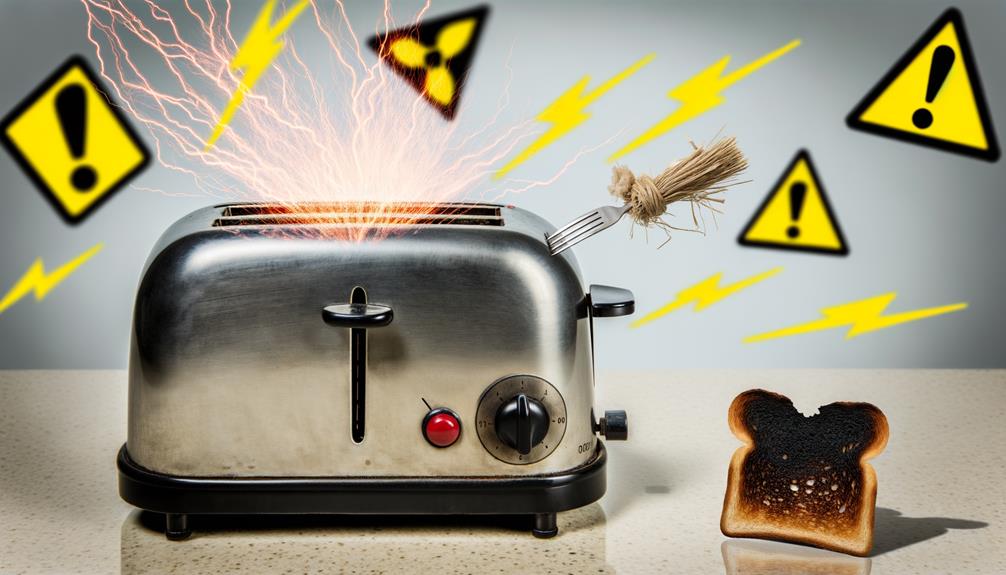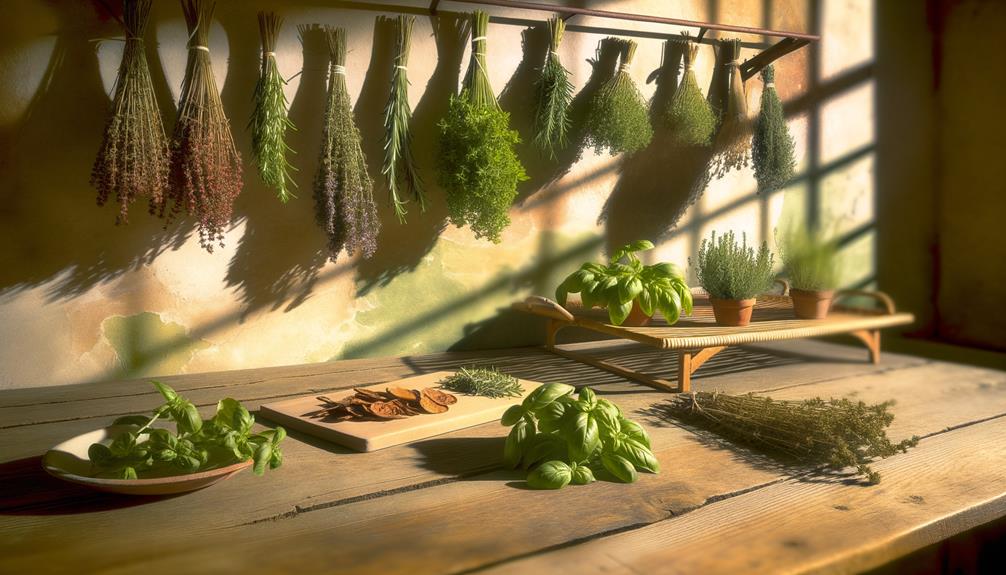When it comes to choosing the right pan for your kitchen, the decision often comes down to carbon steel versus stainless steel. These two materials have distinct properties and uses that can greatly impact your cooking experience. In this article, we will delve into the differences between carbon steel and stainless steel pans, exploring their unique characteristics and benefits.
Table of Contents
ToggleKey Takeaways:
- Carbon steel pans heat better than stainless steel but are slower and more uneven compared to aluminum and copper.
- Stainless steel pans are clad with aluminum and/or copper to improve heat conductivity.
- Carbon steel pans are heavier than stainless steel pans.
- Proper seasoning is required for carbon steel pans to prevent rusting.
- Stainless steel pans are durable, rust-resistant, and won’t react with foods.
- Carbon steel pans are best for specific cooking applications like skillets, omelet pans, crepe pans, woks, and enameled cookware.
- Stainless steel pans are versatile and suitable for all types of cooking.
- Carbon steel pans can become semi-nonstick when seasoned, while stainless steel pans can stick to food.
- Carbon steel pans are often used in French and Chinese cuisines, while stainless steel pans are popular in professional kitchens.
- Stainless steel pans are more resistant to rust and maintain their appearance better than carbon steel pans.
- Carbon steel pans are generally cheaper, while stainless steel pans offer a wider range of brands and types.
- It is recommended to have both carbon steel and stainless steel pans in your kitchen for different cooking needs.
Understanding Carbon Steel and Stainless Steel Pans
When it comes to choosing the right cookware for your kitchen, carbon steel and stainless steel pans are two popular options that offer distinct characteristics and advantages. Understanding the unique features of each type can help you make an informed decision based on your cooking preferences and needs.
Carbon steel pans are known for their exceptional heat conductivity. They heat up quickly and evenly, making them ideal for tasks that require high heat and precise temperature control. However, it’s important to note that carbon steel pans do not heat as quickly or evenly as materials like aluminum or copper. To enhance their heat distribution, some stainless steel pans are clad with aluminum or copper layers, offering the best of both worlds.
Stainless steel pans are renowned for their durability and resistance to rust, corrosion, and food reactions. These pans are made with a combination of iron, carbon, and other metals, making them highly resilient and long-lasting. Additionally, stainless steel pans are versatile and suitable for all types of cooking, from searing and sautéing to boiling and simmering.
When it comes to maintenance, carbon steel pans require seasoning to prevent rust and maintain their nonstick properties. On the other hand, stainless steel pans do not require seasoning and are dishwasher safe. It’s worth noting that while carbon steel pans can develop a semi-nonstick surface when seasoned, stainless steel pans can stick to food. However, with proper cooking techniques and the use of fats or oils, stainless steel pans can be just as effective.
| Carbon Steel Pans | Stainless Steel Pans |
|---|---|
| Heats quickly and evenly | Durable and resistant to rust and corrosion |
| Requires seasoning to prevent rust | Does not require seasoning |
| Best for skillets, omelet pans, crepe pans, and woks | Versatile and suitable for all types of cooking |
| Can develop a semi-nonstick surface when seasoned | Can stick to food, but proper techniques can prevent sticking |
| Popular in French and Chinese cuisines | Popular in professional kitchens |
While carbon steel pans tend to be more affordable, stainless steel pans offer a wider range of brands and options. Whether you prefer the excellent heat conductivity of carbon steel or the durability and versatility of stainless steel, it’s recommended to have both types in your kitchen to cater to different cooking needs.
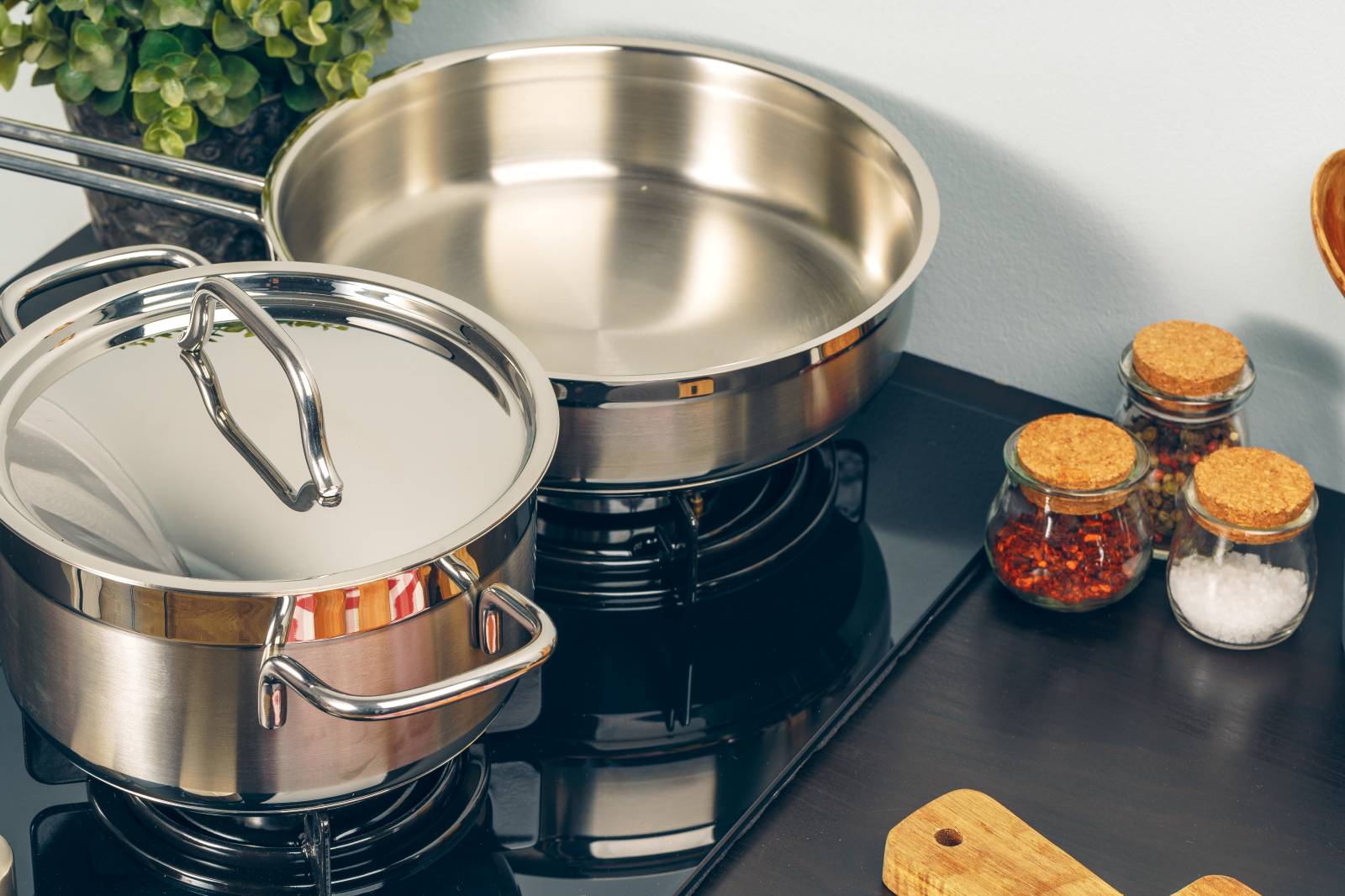
Heat Conductivity: Carbon Steel vs. Stainless Steel
When it comes to heat conductivity, carbon steel and stainless steel pans have distinct differences. Carbon steel is known for its superior heat conductivity, which allows it to heat up quickly. However, it is important to note that carbon steel is slower and more uneven in heating compared to materials like aluminum and copper. On the other hand, stainless steel is not known for its excellent heat conductivity. To overcome this limitation, stainless steel pans are often clad with aluminum and/or copper to enhance their heat distribution and ensure more even cooking.
In terms of weight, carbon steel pans are generally heavier than stainless steel pans. This weight can provide stability during cooking and a solid feel in the hand. It is worth noting that some people prefer the heft of carbon steel pans, while others may find them too heavy for their liking. Stainless steel pans, on the other hand, have a lighter weight, making them easier to handle and maneuver in the kitchen.
When it comes to durability, both carbon steel and stainless steel pans have their advantages. Carbon steel pans are renowned for their exceptional durability and longevity. With proper care and maintenance, they can last a lifetime. However, carbon steel pans require seasoning to prevent rusting. Seasoning involves coating the pan with oil and heating it to create a natural non-stick surface and protect it from rust. On the other hand, stainless steel pans are also highly durable and do not rust, corrode, or react with foods. They are designed to withstand regular use and are often dishwasher safe, making them easier to clean and maintain.
| Carbon Steel | Stainless Steel | |
|---|---|---|
| Heat Conductivity | Superior | Lower, but enhanced with aluminum and/or copper cladding |
| Weight | Heavier | Lighter |
| Durability | Extremely durable, but requires seasoning to prevent rusting | Highly durable, rust-resistant, and easy to clean |
When it comes to cooking applications, carbon steel pans are well-suited for skillets, omelet pans, crepe pans, woks, and enameled cookware. They excel in high-heat cooking methods like stir-frying and searing. On the other hand, stainless steel pans are versatile and suitable for all types of cooking, making them a popular choice in professional kitchens. They are great for tasks that require precise temperature control, such as sautéing, simmering, and sauce-making.
In terms of non-stick properties, carbon steel pans can develop a semi-nonstick surface when seasoned properly. This seasoning process involves building up layers of oil that provide a natural non-stick coating. On the other hand, stainless steel pans do not have non-stick properties and can stick to food. However, they can be used with cooking techniques that do not require a non-stick surface, such as browning or deglazing.
In conclusion, carbon steel and stainless steel pans have their own unique properties and uses. Both are durable and offer benefits in different cooking situations. Carbon steel pans excel in high-heat cooking and are ideal for specific cuisines like French and Chinese. Stainless steel pans are versatile and suitable for all types of cooking, making them popular among professional chefs. It is recommended to have both types of pans in your kitchen to fully enjoy the advantages they bring to your culinary adventures.
Weight and Durability: Carbon Steel vs. Stainless Steel Pans
When it comes to weight and durability, carbon steel and stainless steel pans have their own unique qualities. Carbon steel pans are known for their heavier construction, providing a solid and substantial feel in your hand. This weightiness makes them ideal for tasks that require a strong and sturdy pan, such as searing meats and stir-frying vegetables.
On the other hand, stainless steel pans are often lighter in weight due to their composition. Stainless steel is typically clad with aluminum and/or copper, which not only helps with heat conductivity but also reduces the overall weight of the pan. This lighter weight can be advantageous for tasks that require frequent flipping or tossing, like sautéing or making delicate crepes.
In terms of durability, carbon steel pans are renowned for their long-lasting capabilities. With proper care and seasoning, these pans can withstand high heat, repeated use, and even the test of time, making them a worthy investment for any kitchen. Stainless steel pans, on the other hand, are also highly durable and resistant to rust, corrosion, and food reactions, ensuring they remain in top condition for years to come.
| Category | Carbon Steel Pans | Stainless Steel Pans |
|---|---|---|
| Weight | Heavier | Lighter |
| Durability | Extremely durable | Durable and resistant to rust, corrosion, and food reactions |
While both carbon steel and stainless steel pans have their own strengths in terms of weight and durability, it’s important to consider your specific cooking needs and preferences. Whether you prefer the heft and robustness of carbon steel or the lighter and more versatile nature of stainless steel, both types of pans can enhance your culinary experience and withstand the demands of your kitchen.
Seasoning and Rust Resistance: Carbon Steel vs. Stainless Steel Pans
When it comes to seasoning and rust resistance, carbon steel pans and stainless steel pans have some key differences. Carbon steel pans, while incredibly durable, require seasoning to prevent rusting. Seasoning involves applying a thin layer of oil and heating the pan to create a non-stick surface and protect it from moisture. This process not only enhances the non-stick properties of the pan but also helps to build up a natural patina over time, improving its performance with each use.
In contrast, stainless steel pans do not require seasoning. Thanks to their corrosion-resistant properties, they are naturally resistant to rust and can withstand exposure to moisture without any special treatment. Stainless steel pans are also non-reactive, meaning they won’t interact with acidic or alkaline foods, preserving the taste and quality of your dishes.
Table 5.1: Comparison of Seasoning and Rust Resistance
| Pan Type | Seasoning Required | Rust Resistance |
|---|---|---|
| Carbon Steel | Yes | Requires regular seasoning to prevent rust |
| Stainless Steel | No | Naturally rust-resistant, does not require special treatment |
While stainless steel pans have the advantage of not requiring regular seasoning, carbon steel pans can develop a natural non-stick surface when properly seasoned. This makes carbon steel pans ideal for cooking delicate foods such as eggs and fish, as well as for achieving a perfect sear on meats. The seasoned layer on carbon steel pans also imparts a unique flavor to your dishes over time, making them a favorite among seasoned chefs.
It’s important to note that carbon steel pans can rust if not properly cared for. After each use, it’s essential to wash them with mild soap and warm water, then thoroughly dry them to prevent moisture from sitting on the surface. Proper maintenance and regular re-seasoning will ensure the longevity of your carbon steel pan.
Versatility and Cooking Applications: Carbon Steel vs. Stainless Steel Pans
When it comes to versatility in the kitchen, both carbon steel and stainless steel pans have their own unique advantages. Carbon steel pans, such as the popular carbon steel skillet, are well-known for their excellent heat conductivity. They heat up quickly and provide even distribution across the cooking surface, making them ideal for tasks that require precise temperature control. Carbon steel pans are a staple in French and Chinese cuisines, where they are commonly used for sautéing, stir-frying, and searing.
On the other hand, stainless steel frying pans are incredibly versatile, suitable for all types of cooking. Stainless steel pans are often clad with aluminum and/or copper to enhance their heat conductivity, allowing for faster and more even heating. The smooth and non-reactive surface of stainless steel makes it perfect for tasks that involve simmering, boiling, and braising. Whether you’re making a delicate sauce or a hearty stew, stainless steel pans deliver consistent results.
Both carbon steel and stainless steel pans have their own strengths in the kitchen. Carbon steel pans excel in high-heat cooking methods, providing excellent searing and browning capabilities. They are also well-suited for omelet pans, crepe pans, woks, and enameled cookware. On the other hand, stainless steel pans offer versatility and durability. They do not rust, corrode, or react with foods, making them ideal for everyday cooking.
Carbon Steel Skillet vs. Stainless Steel Frying Pans: A Comparison
| Carbon Steel Skillet | Stainless Steel Frying Pans |
|---|---|
| Suitable for high-heat cooking | Versatile for all types of cooking |
| Heat up quickly and distribute heat evenly | Clad with aluminum and/or copper for enhanced heat conductivity |
| Best for sautéing, stir-frying, and searing | Perfect for simmering, boiling, and braising |
| Require seasoning to avoid rusting | Do not rust, corrode, or react with foods |
| Heavier in weight | Durable and maintain their appearance |
| Best suited for French and Chinese cuisines | Popular choice in professional kitchens |
In conclusion, both carbon steel and stainless steel pans have their own unique qualities that make them valuable additions to any kitchen. Whether you’re searing a steak or simmering a sauce, carbon steel and stainless steel pans offer versatility and durability. Consider having both types of pans in your kitchen to cover a wide range of cooking needs, and enjoy the benefits of each material’s properties.
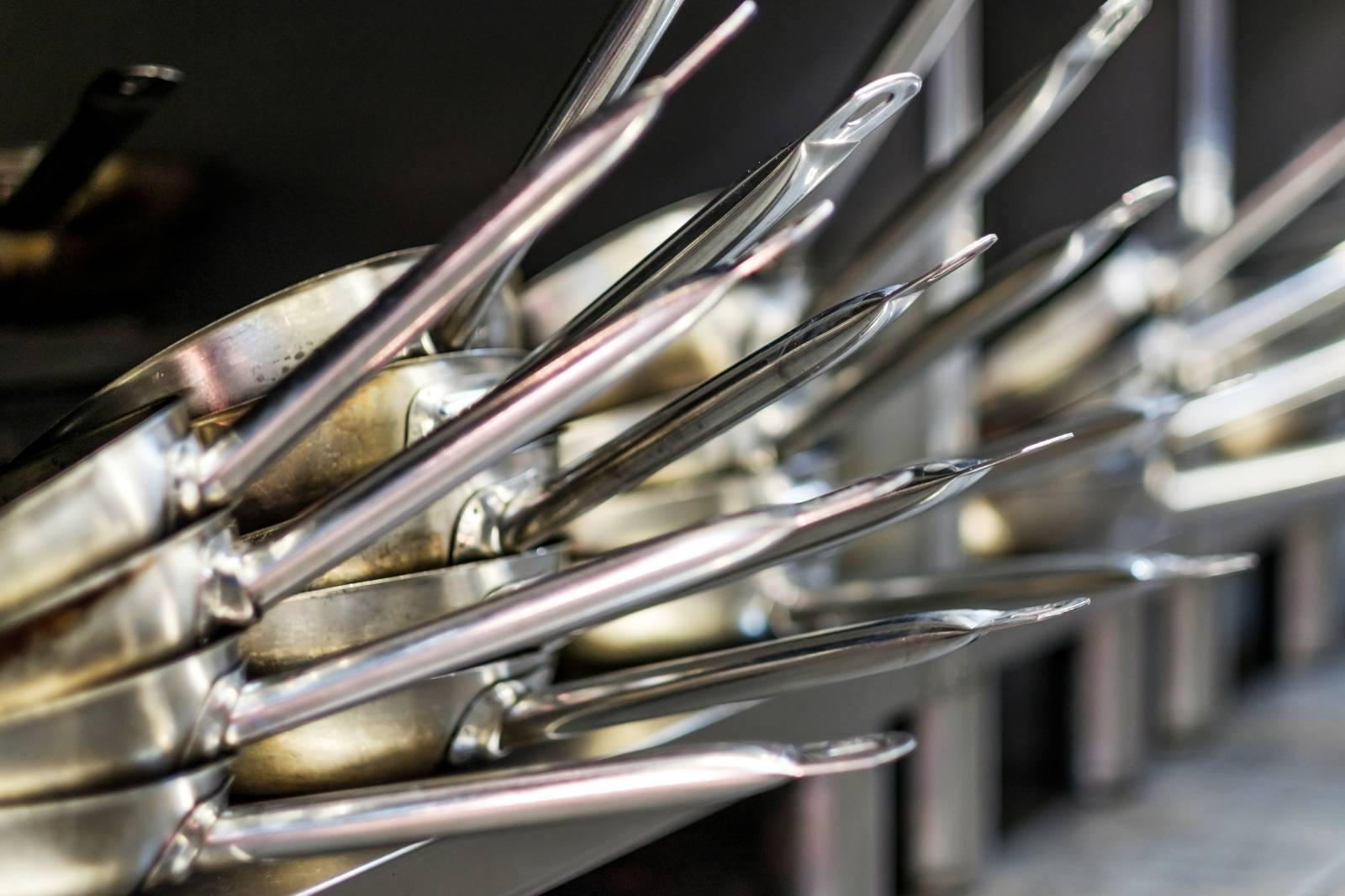
Non-Stick Properties: Carbon Steel vs. Stainless Steel Pans
When it comes to non-stick properties, carbon steel and stainless steel pans have some important differences. Carbon steel pans, especially when properly seasoned, offer a semi-nonstick surface that helps prevent food from sticking. The seasoning process involves applying a layer of oil to the pan’s surface and heating it, creating a natural non-stick coating. This makes carbon steel pans ideal for cooking delicate foods like eggs, fish, and pancakes.
On the other hand, stainless steel pans do not have a non-stick coating. Food can easily stick to the surface, making them less suitable for dishes that require delicate handling. However, stainless steel pans are highly versatile and durable, and they excel in other areas. They can withstand high heat and are perfect for browning and searing meats, creating fond, and achieving delicious caramelization.
“A well-seasoned carbon steel fry pan is like a dream to cook with. It’s naturally non-stick and allows for even heat distribution, making it perfect for sautéing vegetables or searing meats,” says Chef James, a professional cook with over 15 years of experience.
| Carbon Steel Pans | Stainless Steel Pans |
|---|---|
| Semi-nonstick when properly seasoned | No non-stick coating |
| Ideal for delicate foods | Great for browning and searing |
| Requires seasoning to maintain non-stick properties | Food can stick to the surface |
While carbon steel pans offer a natural non-stick surface, it’s essential to properly maintain and season them to retain their non-stick properties. On the other hand, stainless steel pans provide durability and versatility, although they require more attention when cooking to avoid food sticking.
Ultimately, when choosing between carbon steel and stainless steel pans, consider the types of dishes you frequently cook and your cooking style. Having a combination of both in your kitchen can give you the best of both worlds, allowing you to enjoy the benefits of each type of pan for different culinary needs.
Popular Cuisines and Professional Use: Carbon Steel vs. Stainless Steel Pans
When it comes to popular cuisines and professional use, both carbon steel and stainless steel pans have their own unique advantages. Carbon steel pans are highly favored in French and Chinese cuisines for their excellent heat retention and versatility. Professional chefs appreciate the even heat distribution and quick responsiveness of carbon steel pans, making them ideal for delicate tasks like flipping omelets and creating crispy crepes.
On the other hand, stainless steel pans are a staple in many professional kitchens for their durability and versatility. These pans are suitable for all types of cooking, from searing and browning to simmering and sautéing. They are often chosen by chefs for their ability to handle high heat and their resistance to corrosion, making them perfect for rigorous use in commercial settings.
Notably, carbon steel woks are considered essential for authentic stir-frying due to their ability to reach high temperatures quickly and evenly distribute heat. The lightweight nature of carbon steel makes it easier to maneuver the wok during the cooking process, allowing for efficient tossing and stir-frying techniques.
The Role of Carbon Steel and Stainless Steel in Professional Kitchens
Professional chefs understand the importance of having both carbon steel and stainless steel pans in their culinary arsenal. Carbon steel pans offer superior heat retention and responsiveness, allowing for precise cooking techniques. They excel at creating uniquely seared flavors and are favored for their ability to develop a natural non-stick surface when properly seasoned.
On the other hand, stainless steel pans are valued for their durability and resistance to wear and tear. They are highly versatile, capable of handling a wide range of cooking methods. Their ability to withstand high temperatures and resist corrosion makes them invaluable in fast-paced, high-pressure kitchen environments. From sautéing vegetables to searing meats, stainless steel pans deliver consistent performance and professional-grade results.
While carbon steel pans have their strengths in specific cuisines and cooking techniques, stainless steel pans offer a reliable and consistent option for various culinary applications. By having both carbon steel and stainless steel pans in your kitchen, you can embark on a culinary journey that embraces the best of both worlds, elevating your cooking experience to new heights.
| Carbon Steel Pans | Stainless Steel Pans |
|---|---|
| Preferred in French and Chinese cuisines | Popular in professional kitchens |
| Excellent heat retention and versatility | Durable and versatile |
| Ideal for skillets, omelet pans, crepe pans, and woks | Suitable for all types of cooking |
| Must be seasoned to avoid rusting | Won’t rust, corrode, or react with foods |
| Exceptional heat conductivity | Resistant to corrosion and wear and tear |
| Semi-nonstick when seasoned | May stick to food |
Rust and Corrosion Resistance: Carbon Steel vs. Stainless Steel Pans
When it comes to rust and corrosion resistance, stainless steel pans have a clear advantage over carbon steel skillets. Stainless steel is naturally resistant to rust, corrosion, and even the acidic properties of certain foods. This makes it a reliable choice for those looking for a pan that will maintain its appearance over time. With proper care, a stainless steel pan can last for many years without any signs of rust or corrosion.
On the other hand, carbon steel pans require more attention to prevent rusting. Although durable and long-lasting, carbon steel skillets are prone to rust if not properly seasoned and stored. Seasoning is the process of coating the pan with a thin layer of oil to create a protective barrier against moisture. By regularly seasoning your carbon steel pan, you can prevent rust and ensure its longevity. However, it’s important to note that even with proper seasoning, carbon steel pans may still develop rust if not maintained correctly.
In summary, stainless steel pans offer superior rust and corrosion resistance compared to carbon steel skillets. If you’re looking for a pan that requires less maintenance and is more resistant to rust, stainless steel is the ideal choice. However, with proper care and seasoning, carbon steel pans can also provide excellent durability and performance in the kitchen.
| Carbon Steel | Stainless Steel | |
|---|---|---|
| Rust Resistance | Prone to rust if not properly seasoned and maintained | Naturally resistant to rust and corrosion |
| Corrosion Resistance | May develop corrosion if not properly seasoned and maintained | Highly resistant to corrosion and food acids |
| Longevity | Can last forever with proper care | Can also last for many years with proper care |
Cost and Availability: Carbon Steel vs. Stainless Steel Pans
When it comes to choosing the right pans for your kitchen, cost and availability are important factors to consider. Carbon steel pans and stainless steel pans both have their own advantages, and understanding their price ranges and availability can help you make an informed decision.
Carbon steel pans are known for being more affordable than their stainless steel counterparts. This makes them a popular choice for budget-conscious cooks who still want high-quality cookware. Whether you’re looking for a carbon steel skillet or a set of carbon steel fry pans, you’ll find that they are generally cheaper compared to stainless steel pans of similar sizes and brands.
On the other hand, stainless steel pans offer a wider range of options in terms of brands and types. These pans are readily available in most kitchen supply stores and online retailers, making it easier to find the specific stainless steel pan that meets your needs. Additionally, stainless steel sets often come with various sizes and configurations, giving you more versatility in the kitchen.
| Pan Type | Cost | Availability |
|---|---|---|
| Carbon Steel | Cheaper | Limited options |
| Stainless Steel | Higher | More options |
Ultimately, the choice between carbon steel and stainless steel pans depends on your budget and specific cooking needs. If cost is a major consideration and you’re looking for a durable and affordable option, carbon steel pans are the way to go. However, if you prefer a wider range of options and versatility in your cookware collection, stainless steel pans will not disappoint.
Cooking Recommendations: Carbon Steel vs. Stainless Steel Pans
When it comes to cooking recommendations, both carbon steel and stainless steel pans have their strengths. Whether you’re a home cook or a professional chef, understanding the best uses for each type of pan can elevate your culinary creations.
If you love the art of traditional French cooking or stir-frying vibrant Asian dishes, carbon steel pans are a must-have. Their excellent heat retention and even heat distribution make them perfect for achieving that perfect sear or stir-fry. Carbon steel fry pans are also ideal for omelets, crepes, and sauteing delicate ingredients. Their semi-nonstick properties, when seasoned properly, make them versatile for various cooking techniques.
On the other hand, stainless steel pans are the workhorses of the kitchen. Their durability and versatility make them suitable for all types of cooking, from simmering sauces to browning meats. Plus, stainless steel is non-reactive, so you can cook acidic dishes without worrying about any metallic taste. If you prefer a pan that can withstand high heat and won’t warp over time, a stainless steel set is the way to go.
Expert Tip: The Perfect Combination
To truly elevate your cooking experience, consider having both carbon steel and stainless steel pans in your kitchen. Carbon steel fry pans can handle high heat and give your dishes that coveted seared crust, while stainless steel pans offer unparalleled durability and versatility. With the right combination, you’ll be equipped to handle any culinary challenge that comes your way.
Remember, each type of pan has its own strengths and weaknesses, so it’s important to choose the right tool for the job. Whether you’re flipping delicate crepes or simmering a rich sauce, having a well-rounded collection of carbon steel and stainless steel pans will make your time in the kitchen a true joy.
| Carbon Steel Pans | Stainless Steel Pans |
|---|---|
| Perfect for French and Chinese cuisine | Ideal for all types of cooking |
| Seasoning required for rust prevention | Won’t rust or corrode |
| Excellent heat retention | Durable and long-lasting |
| Semi-nonstick when properly seasoned | Non-reactive and won’t affect flavor |
| Heavier than stainless steel pans | Can handle high heat without warping |
| Affordable option | Wide range of brands and types available |
Pros and Cons of Carbon Steel and Stainless Steel Pans
When it comes to choosing the right cookware for your kitchen, it’s essential to consider the pros and cons of different materials. In this section, we will analyze the advantages and disadvantages of both carbon steel and stainless steel pans, allowing you to make an informed decision based on your cooking preferences.
Carbon Steel Pans
One significant advantage of carbon steel pans is their excellent heat conductivity. They heat up quickly and evenly, making them ideal for searing meats and achieving a perfect golden-brown crust. However, carbon steel requires more time to heat up compared to materials like aluminum and copper. Additionally, their heat distribution can be slightly uneven, which might require some adjustment in cooking techniques.
Another advantage of carbon steel pans is their exceptional durability. With proper care, these pans can last a lifetime. They are resistant to warping and can withstand high temperatures, making them suitable for a wide range of cooking methods. However, carbon steel pans require seasoning to prevent rusting. This involves applying oil to the pan’s surface and heating it, creating a natural non-stick coating. If not properly seasoned or cared for, carbon steel pans can develop rust.
Stainless Steel Pans
Stainless steel pans offer their own set of advantages. They are known for their durability and resistance to rust, corrosion, and food reaction. Unlike carbon steel, stainless steel pans do not require seasoning and are easy to clean. They maintain their appearance over time, making them a popular choice for those who appreciate the aesthetic appeal of their cookware.
However, stainless steel pans have lower heat conductivity compared to carbon steel. To overcome this limitation, many stainless steel pans are clad with aluminum and/or copper layers. These layers enhance heat distribution, allowing for more even cooking results. While stainless steel pans are versatile and suitable for all types of cooking, they can stick to food, especially when cooking without sufficient oil or fat.
| Carbon Steel Pans | Stainless Steel Pans |
|---|---|
| Excellent heat conductivity | Durable and rust-resistant |
| Requires seasoning to prevent rust | No seasoning required |
| May have uneven heat distribution | Clad with aluminum and/or copper for enhanced heat distribution |
| Suitable for specific cooking applications | Suitable for all types of cooking |
| Heavier than stainless steel pans | Easy to clean and maintain appearance |
Why You Should Consider Having Both Carbon Steel and Stainless Steel Pans
When it comes to equipping your kitchen with the best cookware, it’s essential to consider both carbon steel and stainless steel pans. These two types of pans offer unique properties and benefits that complement each other, allowing you to elevate your cooking experience. Let’s explore why having both heated carbon steel and stainless steel pans in your culinary arsenal is a wise choice.
Firstly, carbon steel pans are a favorite among professional chefs and cooking enthusiasts. They heat up quickly and retain heat exceptionally well, making them ideal for searing steak, stir-frying vegetables, or achieving a perfect golden crust on a delicate piece of fish. Carbon steel pans are also known for their versatility and are commonly used in French and Chinese cuisines, thanks to their ability to create authentic flavors and textures.
On the other hand, stainless steel pans offer durability and rust resistance. They won’t react with acidic foods and are easy to maintain. Stainless steel pans are highly versatile and suitable for all types of cooking, from simmering sauces to sautéing vegetables. They are also commonly used in professional kitchens due to their reliability and even heat distribution.
By having both carbon steel and stainless steel pans, you can enjoy the best of both worlds. Use your heated carbon steel pan when you need rapid and intense heat for searing or stir-frying, while turning to your stainless steel pan for all other cooking tasks. This combination allows you to have precise control over your cooking techniques and experiment with a wide range of recipes.

Table: Comparison of Carbon Steel and Stainless Steel Pans
| Properties | Carbon Steel Pans | Stainless Steel Pans |
|---|---|---|
| Heat Conductivity | Heats up quickly, uneven heating | Clad with aluminum and/or copper for even heat distribution |
| Durability | Extremely durable, can last forever with proper care | Durable and resistant to rust, corrosion, and food reactions |
| Non-Stick Properties | Semi-nonstick when seasoned | Can stick to food |
| Popular Cuisines | French and Chinese | Versatile for all types of cooking |
| Cost and Availability | Cheaper, limited options | More options in terms of brands and types |
In conclusion, having both heated carbon steel and stainless steel pans allows you to take advantage of their respective strengths in the kitchen. Enhance your cooking techniques with the rapid heat of carbon steel, while enjoying the durability and versatility of stainless steel pans. With this combination, you’ll be well-equipped to tackle any culinary challenge and create delicious meals that will impress your family and friends.
Maintenance and Care Tips for Carbon Steel and Stainless Steel Pans
Proper maintenance and care are essential for ensuring the longevity and optimal performance of both carbon steel and stainless steel pans. By following these tips, you can keep your pans in great condition for years to come.
Carbon Steel Frying Pan Care
- Seasoning: To prevent rust and enhance the non-stick properties of your carbon steel frying pan, it is crucial to season it regularly. Simply coat the pan with a thin layer of oil and heat it over medium-high heat until it begins to smoke. Let the pan cool, then wipe off the excess oil. Repeat this process a few times to build up a protective layer.
- Cleaning: Avoid using abrasive scrubbers or harsh chemicals when cleaning your carbon steel frying pan. Instead, use warm water and a soft sponge or cloth to remove any food residue. Dry the pan thoroughly after cleaning to prevent moisture from causing rust.
- Storage: To avoid rusting, store your carbon steel frying pan in a dry place. If stacking pans, place a paper towel or cloth between them to prevent scratches and moisture build-up.
Dishwasher-Safe Stainless Steel Pan Care
- Cleaning: While stainless steel pans are generally dishwasher-safe, handwashing is recommended for better maintenance. Use warm, soapy water and a gentle scrubber or sponge to clean the pan. Avoid using abrasive cleaners or scrubbers that can scratch the surface.
- Stain Removal: If stubborn stains or discoloration occur, create a paste with baking soda and water. Apply the paste to the stains, let it sit for a few minutes, then scrub gently with a sponge or cloth.
- Shine Restoration: Over time, stainless steel pans may lose their shine. To restore their luster, mix equal parts water and vinegar in a spray bottle. Spray the solution onto the pan’s surface and wipe it with a soft cloth or paper towel.
By following these maintenance and care tips, you can ensure that your carbon steel and stainless steel pans stay in excellent condition, providing you with reliable and enjoyable cooking experiences for years to come.
| Carbon Steel Frying Pan Care | Dishwasher-Safe Stainless Steel Pan Care |
|---|---|
| Season the pan regularly to prevent rust and enhance non-stick properties. | Clean the pan with warm, soapy water and a gentle scrubber or sponge. |
| Avoid using abrasive scrubbers and harsh chemicals when cleaning. | Avoid using abrasive cleaners or scrubbers that can scratch the surface. |
| Store the pan in a dry place to prevent rust. | Remove stubborn stains with a paste of baking soda and water. |
| Restore shine by spraying a solution of equal parts water and vinegar. |
Conclusion
When it comes to choosing between carbon steel and stainless steel pans, it’s important to consider their unique properties and uses. Carbon steel pans have excellent heat conductivity, heating up quickly and evenly. However, they are heavier than stainless steel pans and may require seasoning to prevent rusting. On the other hand, stainless steel pans are durable, rust-resistant, and suitable for all types of cooking. They don’t react with foods and maintain their appearance better over time.
Carbon steel pans are perfect for specific cooking applications such as skillets, omelet pans, crepe pans, woks, and enameled cookware. They can develop a semi-nonstick surface when properly seasoned, offering a convenient cooking experience. Stainless steel pans, on the other hand, may stick to food but provide versatility in the kitchen.
In terms of popularity, carbon steel pans are often favored in French and Chinese cuisines, while stainless steel pans are commonly used in professional kitchens. Stainless steel pans are more resistant to rust and corrosion compared to carbon steel pans, making them a long-lasting investment.
When it comes to cost and availability, carbon steel pans are generally cheaper, while stainless steel pans offer a wider range of options from different brands. It is recommended to have both types of pans in your kitchen. This way, you can fully enjoy the benefits of each material and cater to different cooking needs.
So, whether you’re looking to buy carbon steel or stainless steel pans, consider the specific advantages and choose accordingly. Both types offer their own unique qualities, and having a combination of both in your kitchen will ensure a well-rounded and enjoyable cooking experience.

